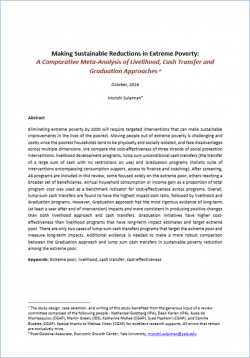
Policy highlights:
- Shifting people out of extreme poverty is both challenging and costly, especially because the poorest households tend to be physically and socially isolated and face disadvantages across multiple dimensions. Given these high costs, a key question for policy makers remains: what is the greatest impact that can be achieved with a limited budget?
- This study compares the cost-effectiveness of three strands of social protection interventions: livelihood development programmes, lump sum unconditional cash transfers (the transfer of a large sum of cash with no restrictions on use) and graduation programmes (a holistic suite of interventions encompassing consumption support, access to finance and coaching).
- Results show the following. 1) Livelihood and lump-sum cash transfer programmes are less effective for targeting the extreme poor, while the graduation approach deliberately targets this group. 2) There is a large diversity in per beneficiary cost for livelihood programmes. Median cost is the highest for graduation programmes and the lowest for cash transfers. 3) In terms of impact, graduation programmes are the most consistent in making significant positive impacts across sites, and livelihood programmes lack sustainability of impacts. 4) Lump-sum cash transfers have the most potential to reduce poverty in general, while the graduation approach has the most impact on extreme poverty.






